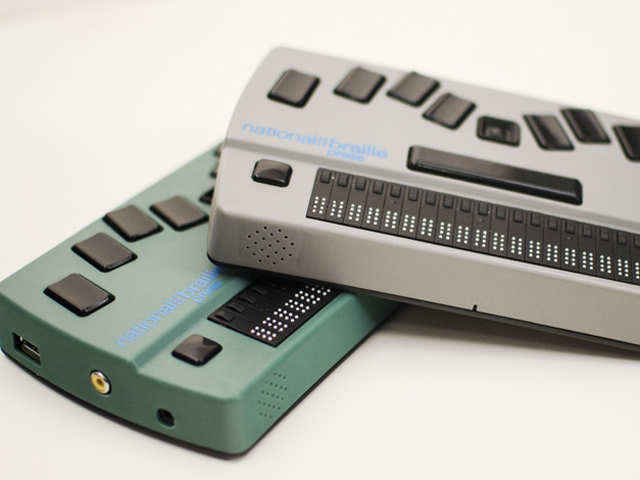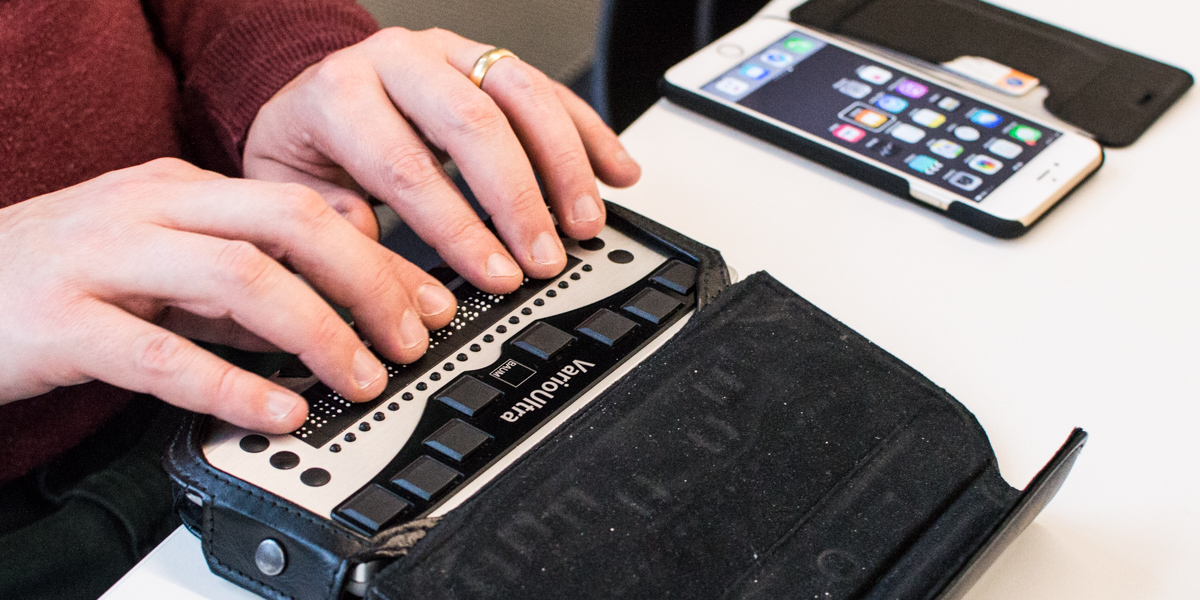Voice-Activated Assistive Devices: Simplifying Regular Tasks
Voice-Activated Assistive Devices: Simplifying Regular Tasks
Blog Article
Discover Ingenious Devices Made for the Aesthetically Impaired
The growth of cutting-edge devices for the aesthetically impaired represents a significant development in access and freedom. Technologies such as wise glasses with AI capacities and mobile applications made to give acoustic summaries are improving daily experiences for customers. Furthermore, wearable devices that use haptic comments enhance environmental understanding, while contemporary Braille technologies offer new methods to engage with message. As these tools continue to evolve, their effect on the lives of those with aesthetic problems increases essential concerns concerning the future of inclusivity and autonomy in various facets of life. What exists ahead in this technological landscape?
Smart Glasses for Navigation

Smart glasses developed for navigation are changing the way aesthetically impaired individuals connect with their atmosphere. These innovative tools utilize a mix of camera modern technology, expert system, and acoustic feedback to offer real-time info regarding environments. By employing barrier detection systems, smart glasses can notify individuals to potential hazards, allowing more secure mobility in both unknown and acquainted settings.
The combination of GPS modern technology additionally improves navigation capacities, enabling customers to get auditory directions as they relocate. This hands-free technique not just fosters independence but additionally empowers aesthetically damaged individuals to navigate city landscapes with enhanced confidence. Furthermore, several clever glasses are equipped with features that recognize landmarks and street indicators, providing contextual info that boosts the user experience.
Moreover, the development of these tools is continuously progressing, with business working to boost the accuracy of object acknowledgment and expand the variety of navigational functions. As clever glasses come to be a lot more budget-friendly and available, they hold the possible to dramatically transform day-to-day life for aesthetically damaged individuals. Eventually, these cutting-edge devices stand for a crucial action towards inclusivity, offering boosted wheelchair and a higher feeling of autonomy for individuals browsing the world around them.

Mobile Application for Daily Living
Exactly how can mobile applications enhance the day-to-days live of visually impaired people? Mobile applications are revolutionizing the method visually impaired customers browse their settings, manage day-to-day jobs, and access information. These applications supply crucial assistance with various performances, fostering freedom and improving lifestyle.
Numerous ingenious mobile apps are developed especially for everyday living. As an example, apps like Be My Eyes attach visually damaged users with sighted volunteers through video clip phone calls, permitting them to get real-time support with tasks such as checking out labels or browsing unfamiliar spaces. Seeing AI, developed by Microsoft, makes use of artificial knowledge to define environments, checked out message, and identify objects, successfully transforming a smart device into a powerful tool for everyday support.
Additionally, navigation apps tailored for the aesthetically impaired, such as Aira and BlindSquare, supply audio-based instructions and ecological information, allowing customers to traverse their surroundings securely and confidently. Past navigation and immediate aid, mobile apps additionally sustain organization and job monitoring, with attributes that assist individuals set suggestions, create order of business, and track appointments. In summary, mobile applications act as crucial resources, empowering aesthetically impaired people to lead even more independent and fulfilling lives.
Wearable Technologies for Aid
Empowerment via modern technology is significantly evident in the world of wearable devices created to aid aesthetically damaged people. These cutting-edge tools incorporate perfectly into every day life, boosting navigation and providing crucial feedback to individuals. As an example, smart glasses equipped with video cameras can acknowledge faces and check out message out loud, allowing individuals to connect more confidently in professional and social check my site settings.
An additional remarkable development is making use of haptic comments systems in wearable devices. These systems utilize vibrations or various other tactile signals to convey info concerning the individual's environment, such as barriers or modifications in surface, improving flexibility and safety and security. Wearable technologies likewise consist of wristbands that link to smart devices, signaling customers to notifications with refined vibrations, therefore improving connectivity without reliance on aesthetic cues.
As these modern technologies continue to develop, they are not just improving freedom for visually damaged people yet also promoting a higher feeling of inclusion in society. By connecting the space in between challenges dealt with in daily living and the potential for freedom, wearable modern technologies function as pivotal devices in the quest for equality and empowerment for those with visual problems.
Audio Description Devices
Audio summary tools play a vital role in enhancing ease of access for aesthetically impaired people, supplying them with the capacity to involve with childrens glasses visual media. Mobility aids for visually impaired users. These devices provide narrated summaries of essential aesthetic aspects in films, tv shows, and live performances, ensuring that customers can fully understand the context and emotions conveyed with visuals
Audio description can be incorporated into various systems, including streaming services, movie theater screenings, and live cinema. Several preferred streaming services now include audio summary as an access attribute, enabling customers to choose it quickly. In addition to conventional media, specialized applications also exist, supplying audio summaries for art exhibits, galleries, and various other social occasions.
The performance of audio summary rests on the ability of the storytellers, who have to share visual details succinctly without interfering with the original audio. Developments in this field are additionally paving the way for even more individualized experiences, where customers can change the level of detail and pacing according to their choices.
Braille Innovations and Instruments
Braille developments and devices have actually significantly changed the way aesthetically damaged individuals interact with message and details. Modern innovations have led to the development of versatile devices that boost literacy and self-reliance amongst customers.
Additionally, mobile Braille notetakers incorporate typical Braille input with contemporary capabilities, helping with note-taking, scheduling, and paper editing and enhancing on the go. Assistive technology for the blind. These small devices typically feature text-to-speech abilities, bridging the space in between Braille and auditory information
Furthermore, ingenious Braille printers have arised, permitting customers to generate Braille labels, documents, and educational materials effectively. This availability promotes higher engagement in instructional and specialist atmospheres, ultimately promoting inclusivity.
In addition, research study into smart Braille technologies remains to increase. Gadgets that include expert system are being checked out to offer real-time navigating assistance and contextual information, eye exam prescription improving the customer experience in varied settings. Generally, these innovations reflect a dedication to equipping visually damaged people through modern technology, guaranteeing they can conveniently accessibility and involve with the globe around them.

Final Thought
The improvement of innovative devices for the visually damaged significantly improves independence and lifestyle. Smart glasses, mobile applications, wearable innovations, audio description tools, and Braille technologies collectively encourage people by offering essential navigation support, environmental awareness, and enhanced reading experiences. These technologies not just foster higher addition yet additionally advertise autonomy in day-to-day activities, inevitably contributing to a more equitable and obtainable culture for aesthetically damaged people. Proceeded development in this field holds assurance for more enhancements.
As clever glasses come to be more available and budget-friendly, they hold the potential to dramatically change everyday life for visually damaged customers. Mobile apps are reinventing the way visually damaged customers navigate their atmospheres, handle everyday jobs, and gain access to details. Apps like Be My Eyes attach visually impaired individuals with sighted volunteers using video clip telephone calls, permitting them to obtain real-time help with tasks such as reading tags or navigating unfamiliar spaces.In addition, navigating apps tailored for the visually damaged, such as Aira and BlindSquare, offer audio-based instructions and ecological info, enabling users to traverse their environments securely and with confidence.The innovation of innovative devices for the aesthetically damaged substantially enhances independence and high quality of life.
Report this page